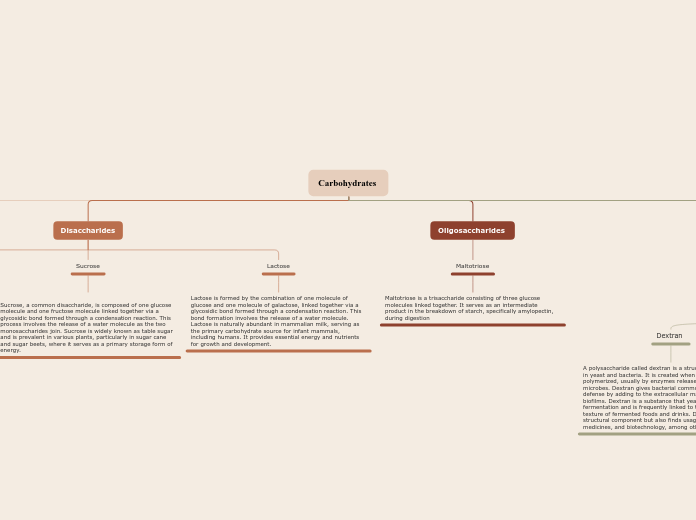Carbohydrates
Monosaccharides
Glucose
Galactose is a monosaccharide, similar to glucose, that contains six carbon atoms. It is commonly found in dairy products, as it is a component of lactose, the primary sugar in milk. Like glucose, galactose serves as a source of energy for living organisms.
Galactose
Galactose is a monosaccharide, similar to glucose, that contains six carbon atoms. It is commonly found in dairy products, as it is a component of lactose, the primary sugar in milk. Like glucose, galactose serves as a source of energy for living organisms.
Fructose
Fructose is another monosaccharide, distinct from glucose and galactose, yet sharing their fundamental role as a source of energy in biological systems. Found abundantly in fruits, honey, and certain vegetables, fructose possesses a five-carbon structure.
Disaccharides
Maltose
Maltose, is a type of disaccharide, it consists of two glucose molecules linked together through a specific type of chemical bond known as a glyosidic bond. This bond forms through a condensation reaction, where a molecule of water is released as the two glucose units join
Sucrose
Sucrose, a common disaccharide, is composed of one glucose molecule and one fructose molecule linked together via a glycosidic bond formed through a condensation reaction. This process involves the release of a water molecule as the two monosaccharides join. Sucrose is widely known as table sugar and is prevalent in various plants, particularly in sugar cane and sugar beets, where it serves as a primary storage form of energy.
Lactose
Lactose is formed by the combination of one molecule of glucose and one molecule of galactose, linked together via a glycosidic bond formed through a condensation reaction. This bond formation involves the release of a water molecule. Lactose is naturally abundant in mammalian milk, serving as the primary carbohydrate source for infant mammals, including humans. It provides essential energy and nutrients for growth and development.
Oligosaccharides
Maltotriose
Maltotriose is a trisaccharide consisting of three glucose molecules linked together. It serves as an intermediate product in the breakdown of starch, specifically amylopectin, during digestion
Polysaccharides
Homo Polysaccharides
Contains single type of monosaccharides
(can be branched or unbranched)
Dextran
A polysaccharide called dextran is a structural element found in yeast and bacteria. It is created when glucose molecules are polymerized, usually by enzymes released by specific microbes. Dextran gives bacterial communities stability and defense by adding to the extracellular matrix of bacterial biofilms. Dextran is a substance that yeast can create during fermentation and is frequently linked to the viscosity and texture of fermented foods and drinks. Dextran serves as a structural component but also finds usage in food processing, medicines, and biotechnology, among other industries.
Starch
Starch, is the main carbohydrate in the human diet, consists of two key components: amylose and amylopectin. Amylose forms a linear polymer of glucose molecules, while amylopectin is a branched polymer. Amylose's linear structure allows for efficient storage and gradual glucose release, aiding in blood sugar regulation. Meanwhile, amylopectin's branching enables rapid glucose mobilization during increased energy demands. Starch-rich foods like grains, potatoes, and legumes are essential sources of energy and nutrition in human diets.
Cellulose
Cellulose is a polysaccharide that serves as a structural component in plant cell walls. It consists of long chains of glucose molecules linked together by glycosidic bonds. This unique bonding pattern creates straight, rigid chains that form hydrogen bonds with adjacent chains, resulting in strong, fibrous structures. Cellulose provides structural support and rigidity to plant cells, contributing to the overall strength and integrity of plant tissues. Additionally, cellulose is a major dietary fiber for many organisms, including humans, where it aids in digestion and promotes gastrointestinal health.
Glycogen
Glycogen serves as the primary storage form of glucose in animals, including humans. Structurally similar to amylopectin but more extensively branched, glycogen is stored predominantly in the liver and muscle cells. This branching allows for rapid hydrolysis and release of glucose when energy demands increase, such as during exercise or periods of fasting. As a dynamic reservoir of energy, glycogen plays a crucial role in maintaining blood glucose levels and providing a readily available source of fuel for various physiological processes. Its storage and mobilization mechanisms are tightly regulated to ensure proper energy balance and metabolic function in animals.
Hetero Polysaccharides
Contains 2 or more types of monosaccharides
(can be branched or unbranched)
